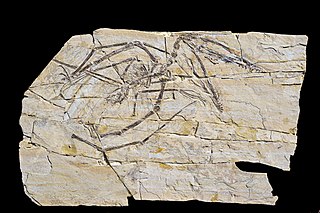 W
WMonofenestrata is an unranked group of pterosaurs that includes the family Wukongopteridae and the suborder Pterodactyloidea.
 W
WAnurognathidae is a family of small pterosaurs, with short or absent tails, that lived in Europe, Asia, and possibly North America during the Jurassic and Cretaceous periods. Five genera are known: Anurognathus, from the Late Jurassic of Germany; Jeholopterus, from the Middle to Late Jurassic of China; Dendrorhynchoides, from the Middle Jurassic of China; Batrachognathus, from the Late Jurassic of Kazakhstan; and Vesperopterylus, from the Early Cretaceous of China. Bennett (2007) claimed that the holotype of Mesadactylus, BYU 2024, a synsacrum, belonged to an anurognathid. Mesadactylus is from the Late Jurassic Morrison Formation of the United States. Indeterminate anurognathid remains have also been reported from the Middle Jurassic Bakhar Svita of Mongolia and the Early Cretaceous of North Korea.
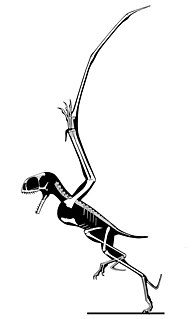 W
WAnurognathus is a genus of small pterosaur that lived during the Late Jurassic period. Anurognathus was first named and described by Ludwig Döderlein in 1923. The type species is Anurognathus ammoni. The genus name Anurognathus is derived from the Greek αν/ an- ("without"), оυρα/ oura ("tail"), and γναθος/ gnathos ("jaw") in reference to its unusually small tail relative to other "rhamphorhynchoid" pterosaurs. The specific name ammoni honours the Bavarian geologist Ludwig von Ammon, from whose collection Döderlein had acquired the fossil in 1922.
 W
WBatrachognathus is an extinct genus of anurognathid pterosaur from the Late Jurassic Karabastau Formation of the central Asian republic of Kazakhstan. The genus was named in 1948 by the Russian paleontologist Anatoly Nicolaevich Ryabinin. The type species is Batrachognathus volans. The genus name is derived from Greek batrakhos, "frog" and gnathos, "jaw", in reference to the short wide head. The specific epithet means "flying" in Latin.
 W
WThe Caelidracones is a group of pterosaurs.
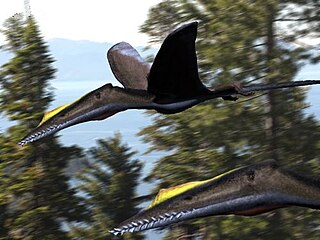 W
WCuspicephalus is an extinct genus of monofenestratan pterosaur known from Dorset in England. Its fossil remains date back to the Late Jurassic period.
 W
WDarwinopterus is a genus of pterosaur, discovered in China and named after biologist Charles Darwin. Between 30 and 40 fossil specimens have been identified, all collected from the Tiaojishan Formation, which dates to the middle Jurassic period, 160.89–160.25 Ma ago. The type species, D. modularis, was described in February 2010. D. modularis was the first known pterosaur to display features of both long-tailed (rhamphorhynchoid) and short-tailed (pterodactyloid) pterosaurs, and was described as a transitional fossil between the two groups. Two additional species, D. linglongtaensis and D. robustodens, were described from the same fossil beds in December 2010 and June 2011, respectively.
 W
WDendrorhynchoides was a genus of anurognathid pterosaur containing only the holotype species D. curvidentatus that is known from the Middle Jurassic Tiaojishan Formation of Qinglong, northern Hebei Province, China.
 W
WDouzhanopterus is an extinct genus of monofenestratan pterosaur from the Late Jurassic of Liaoning, China. It contains a single species, D. zhengi, named by Wang et al. in 2017. In many respects, it represents a transitional form between basal pterosaurs and the more specialized pterodactyloids; for instance, its tail is intermediate in length, still being about twice the length of the femur but relatively shorter compared to that of the more basal Wukongopteridae. Other intermediate traits include the relative lengths of the neck vertebrae and the retention of two, albeit reduced, phalanx bones in the fifth digit of the foot. Phylogenetically, Douzhanopterus is nested between the wukongopterids and a juvenile pterosaur specimen from Germany known as the "Painten pro-pterodactyloid", which is similar to Douzhanopterus in many respects but approaches pterodactyloids more closely elsewhere.
 W
WJeholopterus was a small anurognathid pterosaur from the Middle to Late Jurassic Daohugou Beds of the Tiaojishan Formation of Inner Mongolia, China, preserved with hair-like pycnofibres and skin remains.
 W
WKunpengopterus is a genus of wukongopterid pterosaur from the middle-late Jurassic Tiaojishan Formation of northeastern China. The genus contains two species, the type species K. sinensis and K. antipollicatus.
 W
WPterorhynchus is an extinct genus of pterosaur from the mid-Jurassic aged Daohugou Formation of Inner Mongolia, China.
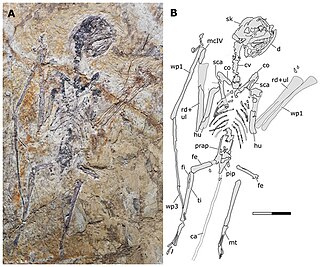 W
WSinomacrops is a genus of extinct anurognathid pterosaur from the Middle to Late Jurassic periods of what is now the Daohugou Beds of the Tiaojishan Formation in Mutoudeng, Qinglong County of the Hebei province. The remains of Sinomacrops date back to around 164 to 158 million years ago. The type and only known species is Sinomacrops bondei.
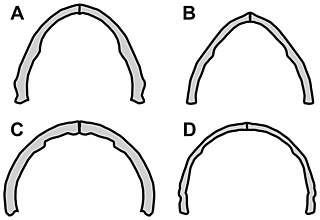 W
WVesperopterylus is a genus of anurognathid pterosaur from the Early Cretaceous Jiufotang Formation of China, the geologically youngest member of its group. Notably, Vesperopterylus appears to have a reversed first toe, which would have been suited for gripping; it was likely arboreal, climbing or clinging to tree branches with curved, sharp claws. It also has a relatively short tail, in contrast with its tailless (Jeholopterus) and long-tailed (Dendrorhynchoides) relatives. It was first described and named by Lü Junchang et al. While the original spelling of the name was Versperopterylus, this was a typo, and was emended by the authors in accordance with the International Code of Zoological Nomenclature.
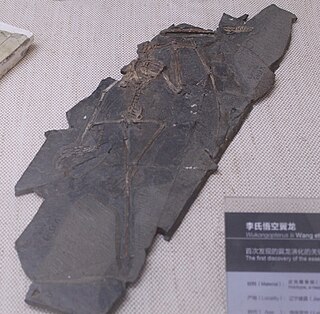 W
WWukongopterus is a genus of basal pterosaur, found in Liaoning, China, from the Daohugou Beds, of the Middle or Late Jurassic. It was unusual for having both an elongate neck and a long tail.